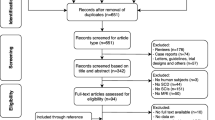Abstract
Stroke is one of the most frequent complications of sickle cell disease (HbSS), occurring in 7–17% of children. Recent studies recognized more minor lesions on MRI, not associated with clinical signs on standard neurological examination, which however have been found to be a risk factor for developing stroke later. The aim of this study was to evaluate whether minor lesions observed on imaging could be associated with ‘soft’ neurological signs not detectable on conventional neurological examination. Fourteen children with HbSS were assessed with MRI, standard neurological examination and evaluation of ‘soft’ signs (Zurich Neuromotor Test) and motor function (Movement ABC). Eight of the 14 children scanned showed lesions on MRI but only 3 of the full cohort were abnormal on standard neurological examination. However, all of the eight children with MRI lesions also showed abnormal signs on at least one of the two tests (Zurich and Movement ABC). All the children with normal MRI were normal on all the tests performed. The sensitivity of Zurich Neuromotor Test and Movement ABC in the group of children with MRI lesions is 0.88 and 0.75, respectively, and increases to 1 when the two tests are used together. The specificity of both tests is 1 even when the tests are used separately.
Similar content being viewed by others
Abbreviations
- ACA :
-
anterior cerebral artery
- DWM :
-
deep white matter
- HbSS :
-
sickle cell disease
- ICA :
-
internal carotid artery
- MCA :
-
middle cerebral artery
- Movement ABC :
-
Movement Assessment Battery Children
- PCA :
-
posterior cerebral artery
References
Adams JR, Nichols FT, McKie V, McKie K, Milner P, Gammal TE (1988) Cerebral infarction sickle cell anemia: mechanism based on CT and MR. Neurology 38: 1012–1017
Connolly K, Stratton P (1964) Development changes in associated movements. Dev Med Child Neurol 10: 49–56
Denckla MB (1973) Development of speed in repetitive and successive finger-movements in normal children. Dev Med Child Neurol 15: 635–645
Denckla MB (1974) Development of motor co-ordination in normal children. Dev Med Child Neurol 16: 729–741
Reference deleted
Henderson SE, Sugden DA (1992) Movement assessment battery for children. Manual, the psychological corporation. Harcourt Brace Jovanich, Sidcup, Kent
Hindmarsh PC, Brozovic M, Brook CGD, Davies SC (1987) Incidence of overt and covert neurological damage in children with sickle cell disease. Postgrad Med J 63: 751–753
Jongmans M, Henderson S, DeVries L, Dubowitz L (1993) Duration of periventricular densities in preterm infants and neurological outcome at 6 years of age. Arch Dis Child 69: 9–13
Kugler S, Anderson B, Cross D, Sharif Z, Sano M, Haggerty R, Prohovnik I, Hurlet-Jensen A, Hilal S, Mohr JP, De Vivo DC (1993) Abnormal cranial magnetic resonance imaging scans in sickle-cell Disease. Arch Neurol 50: 629–635
Latal B (1991) Repetitive, alternierende und sequentielle Bewegungen sowie statische und dynamische Balance im Aller von 5 bis 10 Jahren: Normwerte and correlative Beziehungen. Dissertation Universitats Kinderklinik Zurich Neuromotor Tests 5 to 10 years (ZNT II) test material can be obtained from Abteilung für Wachstum und Entwickung, Kinderspital, CH-8032 Zurich
Pavlakis SG, Bello J, Prohovnik I, Sutton M, Ince C, Mohr JP, Piomelli S, Hilal S, De Vivo DC (1988) Brain infarction in sickle cell anemia: magnetic resonance imaging correlates. Am Neurol 23: 125–130
Portnoy BA, Herier JC (1975) Neurologic manifestiations in sickle cell disease with a review of the literature and an emphasis on the prevalence of hemiplegia. Ann Intern Med 76: 643–652
Powars DR, Wilson B, Imbus C, Pegelow C, Allen J (1978) The natural history of stroke in sickle cell disease. Am J Med 65: 461–471
Stott DH, Moyes FA, Henderson SE (1984) Test of motor impairment, manual. Psychological Corporation LTD Publishing, Windsor, England
Streetly A, Dick M, Layton M (1993) Sickle cell disease: the case for co-ordinated information. BMJ 300: 1491–1492
Sydenstricker VP, Mulherin WA, Houseal RW (1923) Sickle cell anemia. Am J Dis Child 26: 132–154
Uvebrant T (1988) Hemiplegic cerebral palsy: etiology and outcome. Acta Paediatr Scand [Suppl]: 345–356
Witzner M, Masaryk TJ (1991) Cerebrovascular abnormalities in pediatric stroke: assessment using parenchymal and angiographic magnetic resonance imaging. Ann Neurol 29: 585–589
Wolff PH, Gunnoe CE, Cohen C (1983) Associated movements as a measure of developmental age. Dev Med Child Neurol 25: 417–429
Zimmerman RA, Gill F, Goldberg HI, et al (1987) MRI of sickle cell cerebral infarction. Neuroradiology 29: 232–237
Author information
Authors and Affiliations
Rights and permissions
About this article
Cite this article
Mercuri, E., Faundez, J.C., Roberts, I. et al. Neurological ‘soft’ signs may identify children with sickle cell disease who are at risk for stroke. Eur J Pediatr 154, 150–156 (1995). https://doi.org/10.1007/BF01991921
Received:
Accepted:
Issue Date:
DOI: https://doi.org/10.1007/BF01991921




